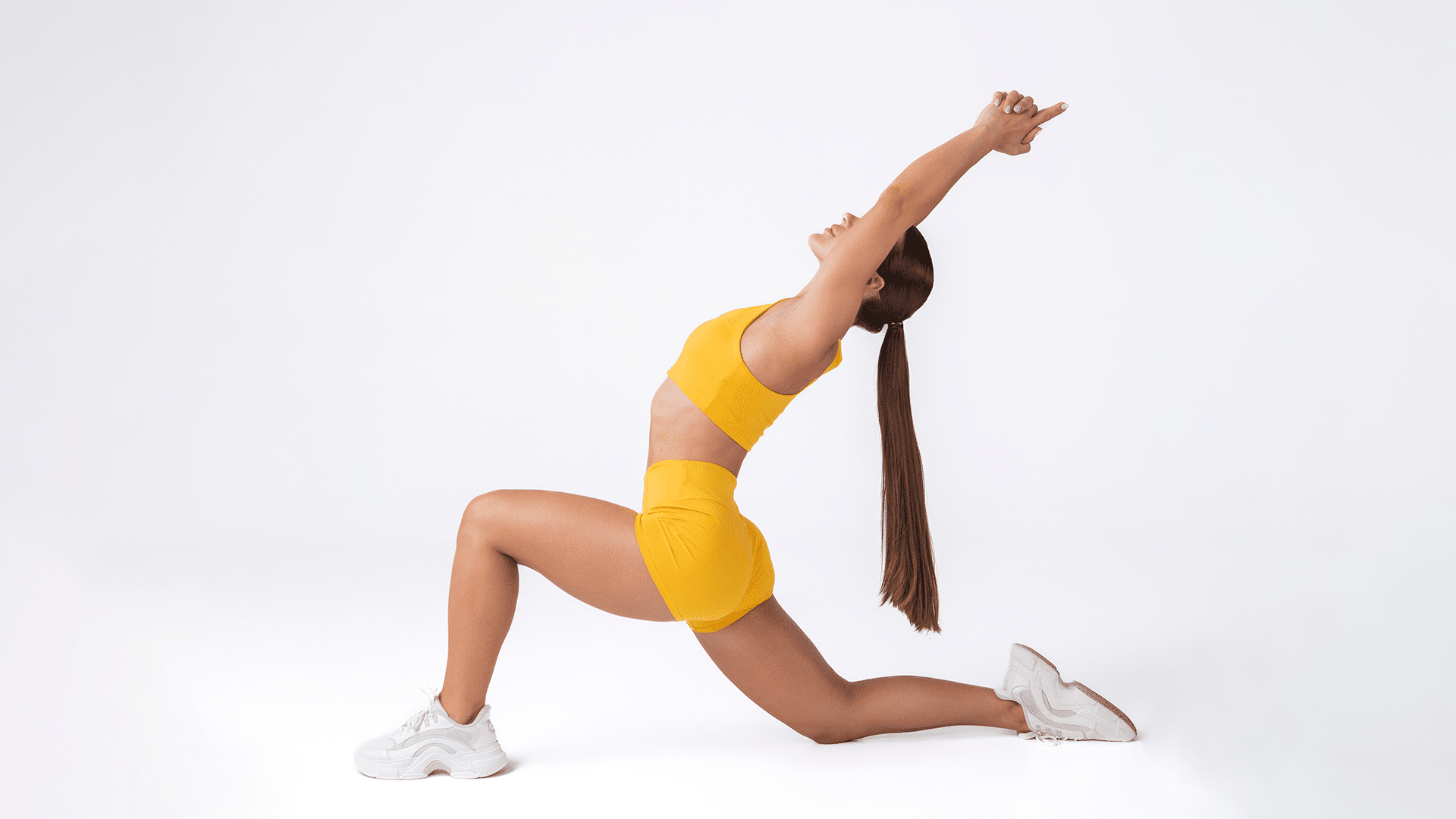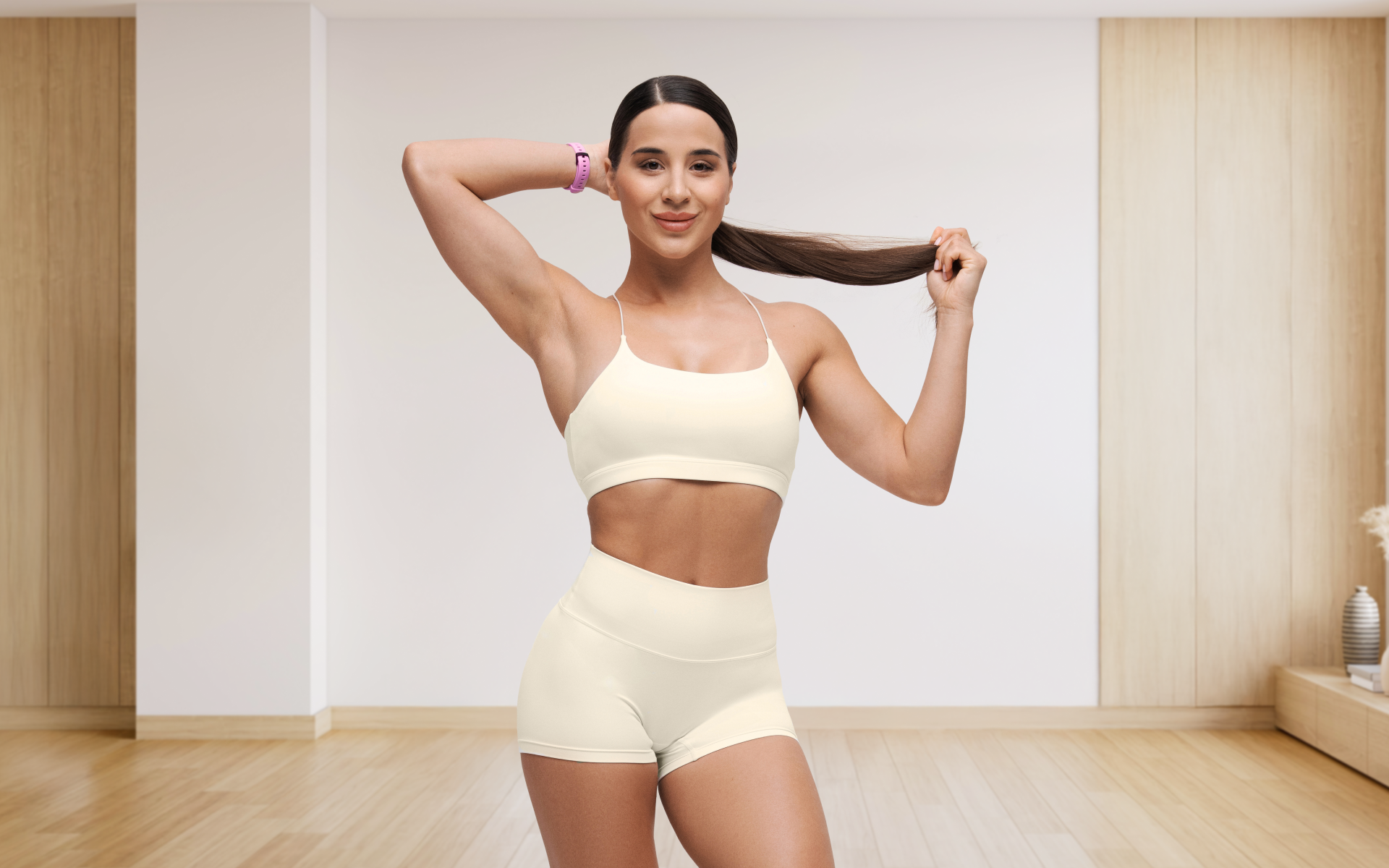Are you tired of back pain or struggling with tight hips? Pilates may be the answer that you have been looking for. With its emphasis on core strength and spinal alignment, Pilates can alleviate aches and pains while improving your overall flexibility.
This type of workout was developed by Joseph Pilates in the early 1920s and is a full-body workout that can help you lose weight and build strength throughout your body! Many people start Pilates on a reformer machine or a mat. Meanwhile there are others who opt to start training with a certified instructor. Although there are several options for learning Pilates and practicing it, you should know that you can perform full-body Pilates workouts on your own, at home.
This article explores the science behind Pilates workouts and the ideal duration for practicing these. Read on to find out!
Is Pilates a Good Full Body Workout?
Yes, of course!
Pilates is an excellent full-body workout. Pilates aims to balance your muscles by strengthening and targeting your larger major muscle groups, as well as your smaller stabilizer muscles (9). Your whole body will benefit from these muscles being stronger and help to give you complete control of your body.
The following are some perks that tag along, making a point of how Pilates is an effective full-body workout:
It Can Enhance Core Strength
Pilates is well-known for its emphasis on the core. This includes all the surrounding muscles of the trunk that can stabilize the body when they are pliable and strong. Even a full-body Pilates workout at home, without any equipment, can improve your core function and strength. Core strength is one of the main factors that helps to decrease hip and back pain. It can also reduce pelvic floor dysfunction, which is the area where explosive movement arises (7).
It Helps Prevent Injuries
Pilates can also balance the muscles of your body. It can help ensure they aren’t loose or weak, neither tight nor rigid. Too weak, tight, rigid, or loose muscles can make our bodies prone to quick injuries. This workout focuses on increasing dynamic strength to support your joints during movements. Authentic research shows that Pilates is a proven method of reducing injury risk in sports (6).
It Can Boost Your Immunity
Studies on older adults have proven that Pilates can boost immune health, especially in older adults (3). Although this research was performed on older adults, the findings suggest that all age groups can experience better immunity through Pilates because it improves blood flow.
It May Improve Posture
Pilates emphasizes the alignment of the entire body. It creates an ideal range of motion from the joints and helps to balance all the opposing muscles. It can enhance your posture by bringing awareness to your alignment while strengthening the neglected postural muscles (2). When performed regularly, you may notice that you can easily sit or stand without feeling neither shoulder nor back pain nor imbalanced muscles.
It Can Improve Your Balance
When a person is weak or out of alignment, the body will need to compensate for these weak or unaligned areas. This results in greater susceptibility to injuries, especially when trying to perform multiple movements simultaneously. Finding and maintaining balance can be easier when the core becomes strong with Pilates. Eventually, when the balance improves, spatial awareness also improves, which can then decrease the likelihood of injury (8)
It Can Enhance Your Mental Health
Another reward of Pilates is that it helps you get in touch with your body when you build strength. Other strength training workouts promote the perception of pushing a person to their limits. This often can lead to a person to ignore the cues of fatigue that they get from reaching their limits. This then leads to a greater potential of injury.
Even though Pilates isn’t a high-intensity workout, it can get your heart pumping. When you perform a full-body Pilates workout with weights, you might experience the feeling of greater satisfaction after each session.
Performing Pilates doesn’t require using fancy machines or training from instructors. You can opt for a full body pilates workout, which includes multiple exercises and offers the ability to train the entire body in a low impact setting!!
If you tend to let yourself off the hook, raise the white flag when things get tougher than you expected, send yourself on an unconscious binge-eating trip – BetterMe app is here to help you leave all of these sabotaging habits in the past!
Is 20 Minutes of Pilates a Day Enough?
Experts recommend performing 45 minutes of Pilates two to three times per week (4). This is because Pilates doesn’t only bring physical rewards. It is also a workout for your mind. Practicing Pilates for a longer time helps you to further connect with your breathing and allows you to enhance your mind-body connection with your breath and get the most out of the mind-body connection. Doing deeper workouts also improves your endurance and makes your movements smoother.
Surprisingly, you don’t need long classes to benefit from Pilates. Let’s be real, most of us don’t have time for full workouts. When you include getting ready, traveling to the studio, and showering afterward, it can take about 2 hours.
That’s too much time!
One way to deal with this problem is to set up a mini Pilates studio at home. You only need a Pilates mat and a good virtual program that guides you at every step. This switch from the studio to home means you can work out whenever you want and how much you desire. The key to achieving the best outcomes is consistency. Work on developing a fruitful Pilates sequence right at home. A carefully designed full-body Pilates workout can include several exercises, including Wall Pilates Moves.
Just make sure that you commit to 20 minutes daily, and you can witness improvements in your overall fitness. Unlike some other exercises, Pilates is completely safe and is helpful for all age groups.
Is It Okay to Do Full Body Pilates Everyday?
Continuing our discussion from above, Pilates is a safe form of exercise for all ages. You can practice it every day and eventually witness positive results on your overall health. Take it slow if you are new to Pilates or recovering from an injury.
Learn full-body Pilates workouts for beginners, and don’t hesitate to seek help from a certified coach if you are finding it difficult to perform the moves.
Let’s not forget that variety is the spice of life. You can create an exciting Pilates routine and combine exercises for each day of the week. A University of Florida study found that people with varied exercise routines enjoyed their workouts 20% more than those who always did the same exercises and 45% more than those without a set schedule. Additionally, they were 63% more likely to stick to their routine than those without structure (1) But always remember, when you are starting on a new workout program you need to take it slow and monitor how your body responds. Everyone’s body is different and what works for one person may not work for another. Be mindful of how you are feeling during the exercise and avoid any painful movements. The workout should be challenging but should not bring you pain.
If you aren’t sure how to create a Pilates routine, we have gathered some exercises for you. These can be included in a full-body Pilates workout that you can do at your home or even at your workplace!
Leg Circles
- Lie on your back with your arms at your sides and your palms facing down.
- Bend your left knee and place your left foot flat on the floor.
- Lift your right leg straight up.
- Move your right leg in a big circle to the side, down towards the floor, and back up to the starting position.
- Keep your lower back on the floor.
- Repeat the circle in the opposite direction.
- Do all repetitions on one leg, then switch to the other leg.
Single Leg Stretch
- Lie on your back. Pull both knees up to your chest, put your hands on your shins, and lift your head off the floor.
- Straighten one leg at a time, switching back and forth between legs.
- Keep your lower back on the floor and your stomach muscles tight.
Table Top
- Lie on your back with your knees bent and feet hip-width apart. Take a deep breath.
- As you breathe out, gently tighten your tummy muscles and lift one leg, keeping your hips, pelvis, and back still. Breathe in and hold that position.
- Breathe and lift your other leg, keeping your tummy tight and your back flat.
- Hold this position for 5 counts while breathing normally.
- Breathe out and slowly lower both feet back to the floor.
Toe Taps
- Lie on your back with your knees bent and feet hip-width apart.
- Exhale and lift one leg to a tabletop position (like in the previous exercise).
- Inhale and hold the position.
- Exhale and lift the second leg to the tabletop, keeping your abs tight and back flat.
- Inhale and hold the position.
- Exhale slowly, lower one foot to the floor while keeping the other leg steady.
- Inhale and bring the leg back to the tabletop.
- Repeat with the other leg.
Read more: Wall Pilates for Butt: A Quick Guide for Beginners
Scissor Kick
- Lie on your back.
- Extend your right leg up, perpendicular to the floor. Place your hands behind your right leg, pulling it toward your face, and lift your head. Raise your left leg a few inches off the floor.
- Switch legs, pulling your left leg in and letting your right leg hover above the floor.
- Keep switching your legs.
Besides these, there are many Pilates exercises that you can find and learn. Mixing these occasionally will stimulate your mind, ensuring you don’t get bored. You select Pilates with weights or pilates using your bodyweight and a wall. Having variety in how your exercise is performed will be beneficial in keeping you committed to the exercise program and preventing you from getting bored down the road!
Remember that human bodies crave routine. That said, add an exercise plan to your routine and stick with it. Soon, you should notice a substantial difference in your physical and mental health.
Can You Get a Good Body Just From Pilates?
Yes, Pilates can help you to achieve a toned body if you perform it consistently and include several exercises in your routine. It is also a great way to improve your flexibility and stability.improve your flexibility and stability by including Pilates in your routine. Due to the low impact nature of these exercises, they will not push your body too hard. This could be beneficial in allowing your body to recover between workouts. exercises don’t usually push your body too hard and prevent you from getting tired. Additionally, pilates has an emphasis on relaxing your body and mind. This can help to decrease overall stress due to the potential for an improved mind-body connection. This might help you get stronger and build some muscle from doing Pilates.
A review published in the Journal of Clinical Medicine in 2019 concluded that Pilates can effectively enhance cardiorespiratory fitness in healthy individuals and those facing aerobic challenges (5). The authors observed that Pilates could boost VO2 max levels, representing the maximum oxygen utilization during intense exercise. This metric is the premier gauge of aerobic endurance and cardiovascular fitness.
On the other hand, if you aim to improve your muscle strength or cardiovascular fitness, you may supplement Pilates with other exercises like High-Intensity Interval Training (HIIT) or weight training. The effectiveness of every exercise depends on your consistency, diet, and how you combine the exercises. One benefit of Pilates is its diversity. You can weigh the benefits of each variation, like Wall Pilates vs Pilates, and curate a routine that keeps you engaged.
Whether you’re looking to simply pep up your fitness routine, jazz up your diet with mouth-watering low-calorie recipes or want to get your act together and significantly drop that number on your scale – BetterMe app has got you covered! Improve your body and revamp your life with us!
FAQs
Is Pilates better than the gym?
This mainly depends on your goals. Pilates includes controlled movements that can help to improve your flexibility and core. Meanwhile, the gym is better for those who want to build muscle mass and strength. Both have benefits, so the choice depends on your goal.
Is Pilates harder than yoga?
Pilates and yoga are both quite challenging. Pilates focuses on precise movements, while yoga enhances relaxation and boosts flexibility. The difficulty experienced depends on your personal fitness level and experience.
Is Pilates better than yoga?
Ranking one better than the other would be a biased statement based on personal preference. Each of these exercises has its own perks. You can also perform both throughout your weekly workout sessions to experience both rewards.
Is Pilates 5 days a week too much?
Pilates 5 days a week is not necessarily too much. Many people practice Pilates daily without issues. However, it is important to listen to your body and vary your workouts accordingly. Find what works for you and remember that everyone is different. What works for one person may not work as well for you. Find that balance!
The Bottom Line
Pilates is a great way to get stronger and healthier overall. It helps you focus on your breathing, balance, and how your mind and body work together. Pilates can not only make you strong but also keep you flexible. It is good for your spine and joints, too. All the benefits of Pilates make us convinced that this branch of workouts can positively impact our mental and physical health.
Now the question is, are you ready to give it a shot?
DISCLAIMER:
This article is intended for general informational purposes only and does not serve to address individual circumstances. It is not a substitute for professional advice or help and should not be relied on for making any kind of decision-making. Any action taken as a direct or indirect result of the information in this article is entirely at your own risk and is your sole responsibility.
BetterMe, its content staff, and its medical advisors accept no responsibility for inaccuracies, errors, misstatements, inconsistencies, or omissions and specifically disclaim any liability, loss or risk, personal, professional or otherwise, which may be incurred as a consequence, directly or indirectly, of the use and/or application of any content.
You should always seek the advice of your physician or other qualified health provider with any questions you may have regarding a medical condition or your specific situation. Never disregard professional medical advice or delay seeking it because of BetterMe content. If you suspect or think you may have a medical emergency, call your doctor.
SOURCES:
- Adding Variety To An Exercise Routine Helps Increase Adherence (2000, news.ufl.edu)
- Effectiveness of pilates method for the posture and flexibility of women with hyperkyphosis (2016, researchgate.net)
- Effects of Pilates Exercise on Salivary Secretory Immunoglobulin A Levels in Older Women (2016, researchgate.net)
- Pilates – health benefits (n.d., betterhealth.vic.gov.au)
- Pilates Method Improves Cardiorespiratory Fitness: A Systematic Review and Meta-Analysis (2019, ncbi.nlm.nih.gov)
- Recommendations for hamstring injury prevention in elite football: translating research into practice (2018, bjsm.bmj.com)
- The Effects of Pelvic Floor Muscle Exercise Combined with Core Stability Exercise on Women with Stress Urinary Incontinence following the Treatment of Nonspecific Chronic Low Back Pain (2022, ncbi.nlm.nih.gov)
- The effects of Pilates training on flexibility and body composition: an observational study (Segal, Neil A. et al., Archives of physical medicine and rehabilitation 85(12), 2004)
- The Relationship of Trunk Muscle Activation and Core Stability: A Biomechanical Analysis of Pilates-Based Stabilization Exercise. (Lee K., International Journal of Environmental Research and Public Health, 18(23), 2021).













